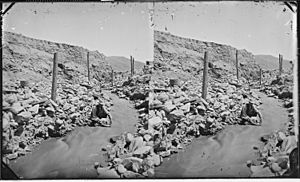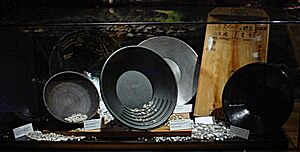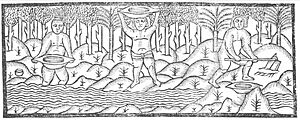Gold panning facts for kids
Gold panning, or simply panning, is a way to find gold. It's a type of placer mining, which means finding valuable minerals in sand or gravel. People use a special pan to separate gold from dirt and rocks. It's one of the easiest ways to find gold. Many people who love geology enjoy it because it doesn't cost much and is quite simple.
People in ancient Rome were among the first to use placer mining. They found gold and other precious metals in streams and mountains. They used tools like sluices and pans.
Today, gold panning doesn't find as much gold as bigger mining methods. For example, large machines are used at places like the Super Pit gold mine in Kalgoorlie, Western Australia. Because of this, gold panning is not often used for big commercial mining anymore.
Contents
How to Pan for Gold
Gold panning is a simple process. First, you need to find a good spot where gold might be. This is often in a riverbed or stream. You scoop some sand and gravel, called alluvial deposits, into your pan.
Next, you add water to the pan. You shake and stir the material well. This helps to loosen the gold from the dirt. This step is called stratification. It makes heavy materials, like gold, sink to the bottom of the pan. Lighter materials float to the top.
Then, you gently wash the lighter materials out of the pan. The heavier materials, including gold, stay at the bottom. These heavy materials often include black sand and tiny pieces of metal. You can then look for and collect the gold.
Even skilled panners can only process a small amount of material. This is much less than what larger mining operations can do. Pans are still used in places where there isn't much money or equipment. They are also popular for recreational gold mining, which is done for fun.
Often, gold panning only finds tiny bits of gold dust. Hobbyists might collect these as souvenirs in small clear tubes. Sometimes, people find bigger gold nuggets or a good amount of dust. However, gold panning is usually not a way to get rich. Panning can also help find the main gold veins that are the source of most placer gold.
Types of Gold Pans
Over the years, many different types of gold pans have been made. They all have ways to trap the heavy gold while you shake the pan. Some pans are made to be used with mercury. Others have screens or sharp corners for breaking ice. Some are not round, and some can even be used without water.
An inventor named Edward Otho Cresap Ord, II patented several pan designs. These included pans for use with mercury or for dry panning.
Gold pans are measured by their diameter. Common sizes are between 10 to 17 inches (25 to 43 cm). The 14-inch (36 cm) pan is the most popular size. The sides of the pan are usually angled between 30 to 45 degrees.
Pans are made from metal or strong plastic. Traditional pans were made from heavy steel. Steel pans are heavier and stronger than plastic ones. Some are made from light metals to be sturdy but not too heavy. Plastic gold pans don't rust or corrode. Most plastic pans have special ridges, called riffles, molded along one side. These riffles help trap the gold. Green and red plastic pans are often liked by prospectors. This is because gold and black sand stand out against these colors. However, many people also choose black pans to easily see the gold.
The Batea Pan
The batea is a special type of gold pan. Its name comes from the Spanish word for "gold pan." Traditionally, bateas were made from a single piece of wood. Today, they can also be made of metal. Bateas are used in places where there isn't much water, like Mexico and South America. The Spanish brought them to these areas. Bateas are larger than other gold pans, often about 20 inches (half a meter) across.
The Yuri-ita Pan
The yuri-ita (揺り板) is a traditional wooden gold pan from Japan. Its name means "rocking plate." Unlike other gold pans, the yuri-ita is rectangular. It has a curved shape and is closed at one end, with the other end open. As its name suggests, you pan for gold with a rocking motion using this tool.
Images for kids
-
Man gold panning in Fairplay, Colorado early 1900s with his dog.
See also
 In Spanish: Bateo de oro para niños
In Spanish: Bateo de oro para niños







